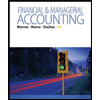
Case A (Requirement (1))
Nonmonetary Exchange
Exchange of non-monetary assets for another non-monetary asset is known as nonmonetary exchange.
Exchange has commercial substance:
If an exchange (Example: exchange of land for another non-monetary asset other than land) is likely to have a change in the future
Exchange lacks commercial substance:
If an exchange (Example: exchange of land for another land) is expected that it will not change the future cash flows, then such exchange is known as exchange lacks commercial substance. In this case, an exchange lacks commercial substance; therefore new non-monetary asset would be value at the book value of the old non-monetary asset.
To determine: The amount of gain or loss that K Farms would recognize on the exchange of tracker, and also determine the initial value of the new tractor.
Case A Requirement (2)
The amount of gain or loss that K Farms would recognize on the exchange of tracker, and also determine the initial value of the new tractor (Assume, the fair value of the old tractor is $14,000).
Case B (Requirement (1))
The amount of gain or loss that K Farms would recognize on the exchange of land, and also determine the initial value of the new land.
Case B (Requirement (2))
The amount of gain or loss that K Farms would recognize on the exchange of land, and also determine the initial value of the land (Assume that the fair value of the old land is $400,000).
Case B (Requirement (3))
The amount of gain or loss that K Farms would recognize on the exchange of land, and also determine the initial value of the land (Assume that the exchange lacks commercial substance).
Want to see the full answer?
Check out a sample textbook solution
Chapter 10 Solutions
INTERMEDIATE ACCOUNTING (LL)(W/CONNECT)
- Please explain the solution to this financial accounting problem with accurate explanations.arrow_forwardI need help with this financial accounting problem using proper accounting guidelines.arrow_forwardInventory: Omega Enterprises has an annual demand for units of inventory of 1,500 per year. The cost of placing an order each time is $75, and each item of inventory costs $3 to store. In this case, what would be the optimal amount of stock that should be ordered?arrow_forward
- Please provide the answer to this general accounting question using the right approach.arrow_forwardDepartment B had 18,000 units in work in process that were 70% completed as to labor and overhead at the beginning of the period; 52,400 units of direct materials were added during the period; 49,500 units were completed during the period, and 13,200 units were 75% completed as to labor and overhead at the end of the period. All materials are added at the beginning of the process. The first-in, first-out method is used to cost inventories. The number of equivalent units of production for conversion costs for the period was ____ Units. (Use FIFO method)arrow_forwardWhat is alvarez's gross profit?arrow_forward
 Financial & Managerial AccountingAccountingISBN:9781285866307Author:Carl Warren, James M. Reeve, Jonathan DuchacPublisher:Cengage Learning
Financial & Managerial AccountingAccountingISBN:9781285866307Author:Carl Warren, James M. Reeve, Jonathan DuchacPublisher:Cengage Learning
